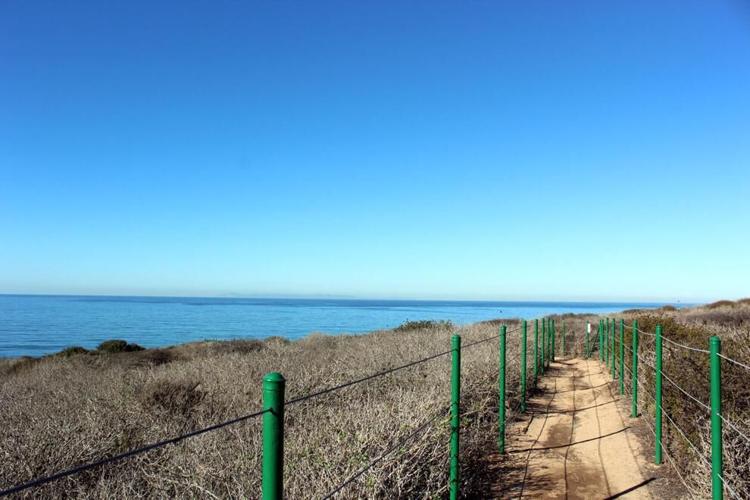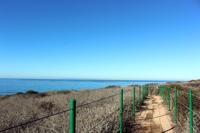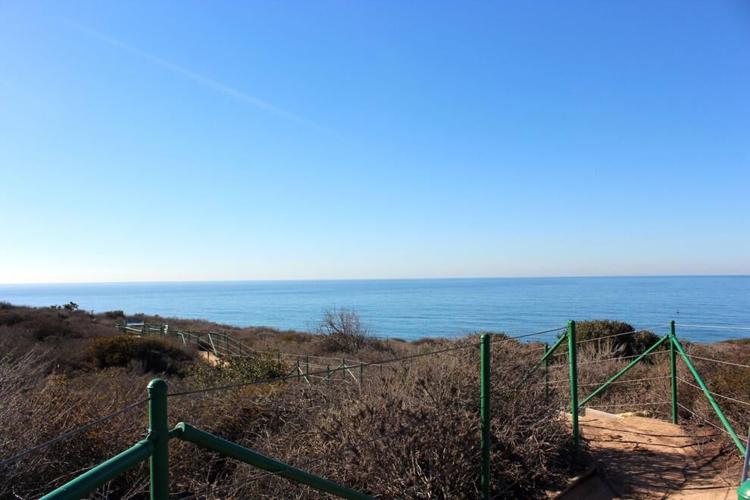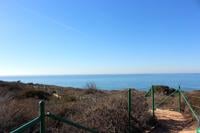On Earth Day this year, the Dana Point Planning Commission sought to codify operating hours for the Headlands Trail on the Dana Point Preserve as the city aims to offer locals and visitors the maximum access to the coastal trail.
Through a Coastal Development Permit (CDP) unanimously approved by Planning Commissioners during the April 22 meeting, the city looks to formally set public access to the trail at 7 a.m. to sunset, daily.
Principal Planner Christopher Johnson explained that the Headlands Conservation Park has been “a very successful public access destination since its inception and provides amazing public views of the coastline in Dana Point.”
The City of Dana Point and the Center for Natural Lands Management (CNLM), the nonprofit that manages the 29-acre coastal preserve, have been in litigation over public access to the trail since Jan. 21, 2022.
Since its opening in April 2010, the Nature Trail allowed public access from 7 a.m. to sunset, seven days a week. However, in response to the pandemic in March 2020, the city closed the public trails that it manages, and CNLM closed the blufftop Nature Trail for public safety.
When the center reopened trails in mid-October 2020, CNLM allowed limited public access from 9 a.m. to noon on Tuesdays and Thursdays, court filings state. In mid-June of 2021, CNLM updated the trail’s hours of operation, increasing them from 8 a.m. to 4 p.m. on Tuesdays, Thursdays and Saturdays.
The lawsuit added that the city advised CNLM that the hours did not meet the requirements set on the nonprofit organization for public use, and requested that the trail’s operating hours return to 7 a.m. to sunset, daily.
In mid-June, CNLM increased the trail’s hours of operation to 8 a.m. to 4 p.m. on Tuesdays, Thursdays and Saturdays. On June 18, 2021, the City of Dana Point issued CNLM a Notice of Violation to encourage the organization to resume regular hours of operation for the trail.
CNLM has argued that limiting and controlling public access to the trail is necessary to protect threatened species such as the Pacific Pocket Mouse (PPM) and Coastal California Gnatcatcher, both of which call the preserve their home.

A sign along the Headlands Trail reminding hikers of flora and fauna in the area. Photo: Breeana Greenberg
In November 2022, the Orange County Superior Court ordered CNLM to open the public’s access to the trail at the Dana Point Preserve seven days a week from 7 a.m. to sunset—just as it used to be prior to the COVID-19 pandemic.
Johnson explained that the Coastal Development Permit application before the Planning Commission “pertains to the future operational hours of the nature trail, which city staff is proposing should remain at 7 a.m. to sunset, seven days a week and throughout the year,” noting that the ongoing litigation is “separate from the CDP decision.”
Representing CNLM, attorney Sarah Mueller spoke in opposition of the city’s move to formally expand public hours to the trail during the April 22 Planning Commission meeting. Mueller argued that the city did not ask for the nonprofit’s consent to apply for the Coastal Development Permit and lacks the legal basis to apply for the permit.
Dana Point Director of Community Development Brenda Wisneski noted that legal counsel reviewed the issue and feels “confident that the city does have the grounds to bring this Coastal Development Permit application forward.”
CNLM’s primary concern with the extended public access hours, Mueller said, “is the preservation of the Dana Point Preserve’s delicate ecosystem.”
“Since the opening of the trail in 2009, visitation has surged, putting immense pressure on the habitat and its species, particularly the Pacific Pocket Mouse,” Mueller continued. “The existence of the Pacific Pocket Mouse is precarious at best, with only two other remaining populations in the world, both at Camp Pendleton.”
Mueller added that just before trail access opened to the public, the nonprofit documented two mice on the preserve. Since then, Mueller explained that CNLM documented 57 Pacific Pocket Mice in 2012, six in 2017 and 77 in 2020 after the nonprofit closed the trail during the COVID pandemic.

The City of Dana Point wants maximum access to the Headlands Trail as litigation with the Center for Natural Lands Management continues. Photo: Breeana Greenberg
“To be clear, CNLM is not seeking to prohibit public access,” Mueller said. “We do not discount the value of the incredible views in the preserve or the interest in connectivity with other trails or the desire of residents and visitors to spend time on the preserve.”
“We are not seeking to prohibit public access, but to adjust it to increase the chances of survival of this endangered species aligning with the Coastal Act and local policies that regulate public access to protect sensitive resources,” Mueller continued.
California Native Plant Society, Orange County Chapter Plant Science Chair Ron Vanderhoff also spoke in opposition of the expanded public access, requesting that hours be reduced to those allowed during the pandemic.
“The Dana Point Preserve is home to several sensitive plant species with California rare plant ranks,” Vanderhoff said. “These plants and others are particularly sensitive to foot traffic, poaching and erosion. These are long-term cumulative effects that are very difficult to document in a very short period of time.”
Ahead of the meeting, the U.S. Fish and Wildlife Service and California Department of Fish and Wildlife co-authored a letter recommending the Planning Commission “seek a more restricted public access schedule and retain flexibility to adjust the hours of operation for the public access trail over time based on the status of PPM and use of the adaptive management approach that has been adopted to guide management and provide protection for the Conservation Park’s sensitive resources.”
Several community members spoke in favor of expanded hours of public access to the trail, including Capistrano Beach resident Toni Nelson, who noted that there are not many wilderness areas in Dana Point.
“It is truly the only place where we can observe the native plants that are indigenous to our region and benefit from the sights, smells and sounds that occur along the trails,” Toni said. “I can also appreciate that there are endangered animal species such as the gnatcatcher and the Pacific Pocket Mouse, as well as native plants that must be protected and preserved.”
During the public hearing to discuss the coastal development permit, Toni added that she did not see data in the staff report that would support the limited hours.
“I couldn't see anything on the number of people who attend the park daily,” Toni said. “I haven't noticed a lot of parking issues up there. We have very limited parking, and I just don't think there's that many people on the trail.”
Dana Point resident Denise Erkeneff spoke in favor of the extended public hours, noting that she and her husband have been locked inside the gates of the preserve while walking the trail during daylight hours.
Visit Dana Point Executive Director Heather Johnston added that local trails have served as a tourist attraction.
“We receive weekly requests for local information on trails, and we always want to push them towards trails that are public trails and that people aren't making their own trails,” Johnston said. “In particular, we feel that the trails promote responsible tourism. It also promotes, encourages stewardship for future generations.”
Planning Commission Vice-Chair Eric Nelson explained that after reading the staff report and letters received from conservation groups and NGOs, “I’m not swayed that the solution to the challenges that they raised is one in which we just regulate hours.”
“To me, it doesn't seem like those hours really tie to anything specific; they tie more to operational issues, as opposed to issues relative to the species that we're protecting,” Eric said.
“For me, after reading all of the evidence that’s been presented to us, visiting the site multiple times, walking the trail multiple times and observing the changes and positive changes that have occurred throughout the period of time that the trail was wide open – so for 10 years that trail was accessible on a daily basis – and it’s thrived,” Eric continued.
Eric added that the purpose of the preserve was to “balance the environmental impacts” of development on the Headlands while “preserving and protecting species.”
“I think what we heard tonight is one of the big concerns is that the trails are being used, which is exactly what we want,” Eric said. “We have multiple hotels that have been approved for this area, more to come, which means there's going to be more need to ensure that coastal access is provided.”
During her comments, Toni argued that while both the protection of the park and its flora and fauna are important and public access to the Headlands is important to Dana Point residents, she believed a compromise could be struck.
“I think we can have both if we work together and educate the public appropriately,” Toni Nelson said. “Docents and volunteers can be trained to help the public to appreciate and respect the preserve, to stay within designated trails and use light steps, low voices and a respectful attitude as they enjoy this precious resource.”
The Coastal Development Permit may still be appealed to Dana Point City Council or California Coastal Commission, in which case another public hearing will be held to discuss the nature trail’s public access hours.







